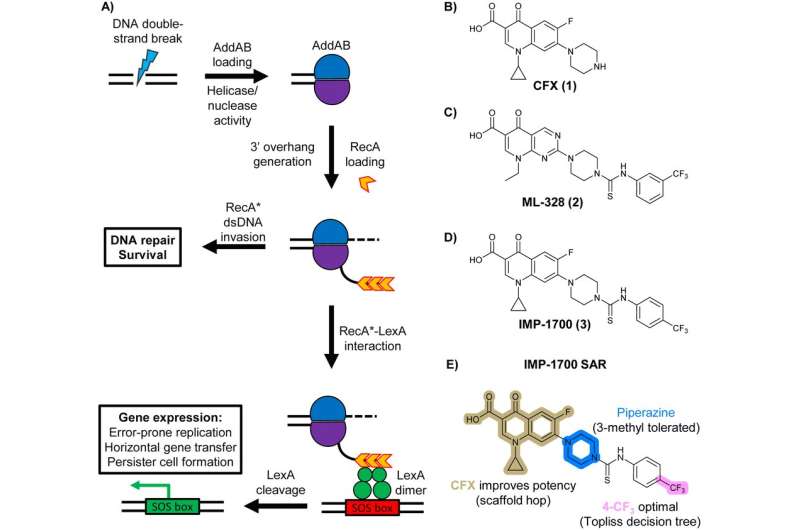This article has been reviewed according to Science X's editorial process and policies. Editors have highlighted the following attributes while ensuring the content's credibility:
fact-checked
peer-reviewed publication
trusted source
proofread
New molecule found to suppress bacterial antibiotic resistance evolution

Researchers from the University of Oxford have developed a new small molecule that can suppress the evolution of antibiotic resistance in bacteria and make resistant bacteria more susceptible to antibiotics. The paper, "Development of an inhibitor of the mutagenic SOS response that suppresses the evolution of quinolone antibiotic resistance," has been published in the journal Chemical Science.
The global rise in antibiotic-resistant bacteria is one of the top global public health and development threats, with many common infections becoming increasingly difficult to treat. It is estimated that drug-resistant bacteria are already directly responsible for around 1.27 million global deaths each year and contribute to a further 4.95 million deaths. Without the rapid development of new antibiotics and antimicrobials, this figure is set to rise significantly.
A new study led by researchers at the Ineos Oxford Institute for antimicrobial research (IOI) and the Department of Pharmacology at Oxford University offers hope in the discovery of a small molecule that works alongside antibiotics to suppress the evolution of drug-resistance in bacteria.
One of the ways that bacteria become resistant to antibiotics is due to new mutations in their genetic code. Some antibiotics (such as fluoroquinolones) work by damaging bacterial DNA, causing the cells to die. However, this DNA damage can trigger a process known as the "SOS response" in the affected bacteria.
The SOS response repairs the damaged DNA in bacteria and increases the rate of genetic mutations, which can accelerate the development of resistance to the antibiotics. In the new study, the Oxford scientists identified a molecule capable of suppressing the SOS response, ultimately increasing the effectiveness of antibiotics against these bacteria.
The researchers studied a series of molecules previously reported to increase the sensitivity of methicillin-resistant Staphylococcus aureus (MRSA) to antibiotics, and to prevent the MRSA SOS response. MRSA is a type of bacteria that usually lives harmlessly on the skin. But if it gets inside the body, it can cause a serious infection that needs immediate treatment with antibiotics. MRSA is resistant to all beta-lactam antibiotics such as penicillins and cephalosporins.
Researchers modified the structure of different parts of the molecule and tested their action against MRSA when given with ciprofloxacin, a fluoroquinolone antibiotic. This identified the most potent SOS inhibitor molecule reported to-date, called OXF-077. When combined with a range of antibiotics from different classes, OXF-077 made these more effective in preventing the visible growth of MRSA bacteria.
In a key result, the team then tested the susceptibility of bacteria treated with ciprofloxacin over a series of days to determine how quickly resistance to the antibiotic was developing, either with or without OXF-077. They found that the emergence of resistance to ciprofloxacin was significantly suppressed in bacteria treated with OXF-077, compared to those not treated with OXF-077.
This is the first study to demonstrate that an inhibitor of the SOS response can suppress the evolution of antibiotic resistance in bacteria. Moreover, when resistant bacteria previously exposed to ciprofloxacin were treated with OXF-077, it restored their sensitivity to the antibiotic to the same level as bacteria that had not developed resistance.
More information: Jacob D. Bradbury et al, Development of an inhibitor of the mutagenic SOS response that suppresses the evolution of quinolone antibiotic resistance, Chemical Science (2024). DOI: 10.1039/D4SC00995A
Journal information: Chemical Science
Provided by University of Oxford





















